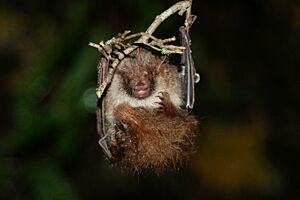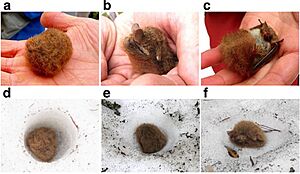Ussuri tube-nosed bat facts for kids
Quick facts for kids Ussuri tube-nosed bat |
|
|---|---|
 |
|
| Conservation status | |
| Scientific classification | |
| Genus: |
Murina
|
| Species: |
ussuriensis
|
 |
|
| Synonyms | |
|
|
The Ussuri tube-nosed bat (Murina ussuriensis) is a small bat known for its unique nose shape. It belongs to a group of bats called vesper bats. Sadly, its home is shrinking due to habitat loss. This bat is special because it's the only known bat that sleeps through winter inside snow!
Contents
About the Ussuri Bat's Name
This bat was first described as a new species in 1913. A Russian scientist named Sergey Ognev gave it its scientific name.
The second part of its scientific name, "ussuriensis", comes from a place called Ussuriland. This is where the first bat of this kind was found. A person named Nikolaus Ikonnikov collected it there.
For a while, some scientists thought it was a type of little tube-nosed bat. They called it Murina aurata ussuriensis. Also, the bats found in Japan are sometimes called Murina silvatica.
What the Ussuri Bat Looks Like
This bat is a medium-sized member of its bat group. Its forearm, from elbow to wrist, is about 27 millimeters (1.1 inches) long. Its head and body together are about 40 millimeters (1.6 inches) long. Its tail is about 25 millimeters (1 inch) long.
The bat has soft, short fur. The fur on its back has three colors: reddish-brown tips, pale middle parts, and dark roots. Its belly fur is lighter and grayish. The tops of its feet and legs are very hairy. The back of its tail membrane (called the uropatagium) is also very furry. These bats usually weigh between 4 and 8 grams (0.14 to 0.28 ounces).
How Ussuri Bats Live
Where Ussuri Bats Sleep
In spring and autumn, these bats often sleep in piles of dead leaves. They also use holes in trees or under peeling tree bark. They like to roost in trees like Litsea acuminata, Neolitsea sericea, and Cinnamomum camphora.
Female bats often change where they sleep. One study showed they might move to a new spot every day! They live in groups, and females form special "maternity colonies" when they have babies. These groups last from June to August. The rest of the year, both male and female bats usually live alone.
These maternity groups can have anywhere from 2 to 22 bats. Because they change roosts often and their group sizes vary, it seems they have a "fission-fusion" social structure. This means groups can split apart and then come back together.
Most amazingly, the Ussuri tube-nosed bat is the only known bat that sleeps through winter in snow. They have been found resting inside round or cone-shaped holes in snowbanks. Scientists think the bats dig these holes themselves. Sleeping in the snow might keep them safe from animals that hunt them. It also helps them avoid losing too much water. The snow holes likely keep the temperature steady, which is important for hibernation. The only other mammal known to hibernate in snow is the polar bear.
Reproduction and Life Cycle
Female Ussuri bats tend to stay in the area where they were born. This means that females in the same area are often related. This affects how their groups are formed.
Females give birth to their babies, called pups, in the summer. The pups stop drinking milk from their mothers in the summer too. Some young bats can have their own babies by their first autumn.
These bats do not live very long compared to some other bat species. The oldest male found lived for 4 years. The oldest female lived for 4.5 years.
Health and Challenges
Like many animals, Ussuri tube-nosed bats can get sick. They can have tiny worms inside their bodies, like a type of tapeworm called Vampirolepis yakushimaensis.
These bats were also among the first in Asia to test positive for a fungus called Pseudogymnoascus destructans. This fungus causes a serious bat disease called white-nose syndrome. One bat in China tested positive for this fungus. However, the disease does not seem to be as deadly to bats in China as it is to bats in the United States.
Where Ussuri Bats Live
You can find the Ussuri tube-nosed bat in several countries. They live in North Korea, South Korea, and Japan. In Japan, they are found on islands like Hokkaido, Honshu, Shikoku, Kyushu, and Yakushima Island. They also live in parts of Russia, including Primorye and the Kuril Islands. There have been reports of them in northeast China, but these need to be confirmed.



